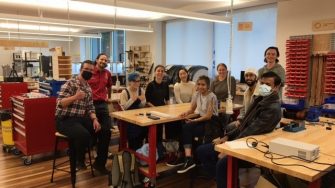Building a boomerang powered drone for Channel 10 series
During Term 3, a group of students from the UNSW Faculty of Engineering spent time working on an innovative project combining the unique features of a boomerang with modern drone technology.
During Term 3, a group of students from the UNSW Faculty of Engineering spent time working on an innovative project combining the unique features of a boomerang with modern drone technology.

The challenge was filmed as part of a new Channel 10 and NITV series called First Inventors, which explores and celebrates the cultural knowledge of First Nations peoples. Hosted by First Nations actor Rob Collins and Directed by Larissa Behrendt, who is also First Nations, the series takes a journey through time and Country with the next generation of knowledge holders to investigate our ancestors’ innovations.
The idea that the boomerang concept could be adapted to for vertical flight was proposed by First Nations inventor David Unaipon in 1914—before the helicopter was invented.
He said, “When I solved the flight of the boomerang...it seemed to me that I could do away with the preliminary run of the aeroplane, and make the machine rise direct from the ground. I know that certain laws on which I work have not been tried before, but I am quite sure I shall be successful. I am aware of the opposing forces; but I know what to do to overcome them.”
Dr Sonya A Brown, Senior Lecturer in Aerospace Design in the UNSW School of Mechanical and Manufacturing Engineering, is leading the project, with the student team driven and supported by senior students Benjamin Tynan and Jasjit Ghataure.
"This has been such a challenging and rewarding opportunity,” said Dr Brown.
“We were able to consider First Nations technology that is tens of thousands of years old in the boomerang, plus David Unaipon's idea of using the boomerang for vertical flight from over 100 years ago and bring it all to life in a modern drone, demonstrating that David Unaipon's idea was possible."
The six students who participated in the challenge represented various schools within the Faculty: Clementine Hobill Cole, Akash Lakshman, Conrad Petrovic and Sophia Nicole Pablo were from the School of Mechanical and Manufacturing Engineering, Natalie Chen was from the School of Photovoltac and Renewable Energy Engineering, Nicole Harrington was from the School of Chemical Engineering and Isabella Zdavkovic was from the School of Computer Science and Engineering.
Isabella Zdavkovic said that despite numerous challenges that included preserving the shape of the boomerang and controlling the amount of lift, it was rewarding to be part of the project.
“This project tested my perseverance and encouraged me to come up with creative ideas to solve the problems we had,” said Isabella.
“I also got to learn so much about how important the shape of the boomerang is and how it helps with the aerodynamics. It makes me proud as an indigenous woman to work with this project.”
Conrad Patrovic said that being able to participate in First Inventors was one of the most exciting and challenging experiences he had encountered at university so far.
“There were many aspects of the project that the entire team knew would be difficult to address, especially since a boomerang-propelled drone had never been designed and prototyped before,” said Conrad.
“One of the biggest achievements of this project was showing that David Unaipon’s idea for a boomerang-propelled aircraft in fact did have great promise. It is an indication that we have a lot to learn from Indigenous science and technology, and that we could potentially use this knowledge as a basis for new developments and advancements in western science.”
The airing date for the First Inventors series is yet to be announced.